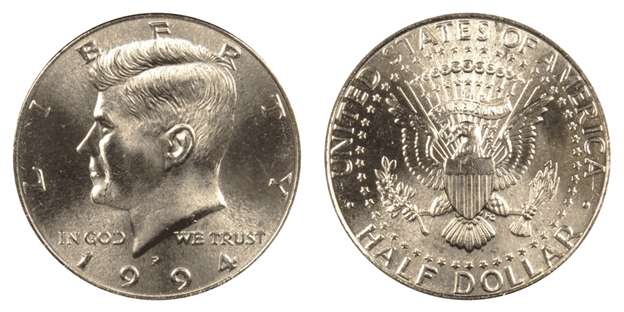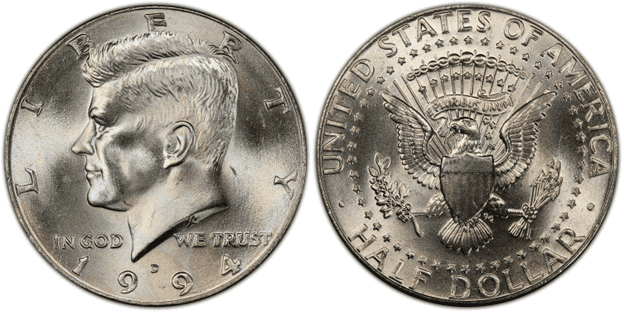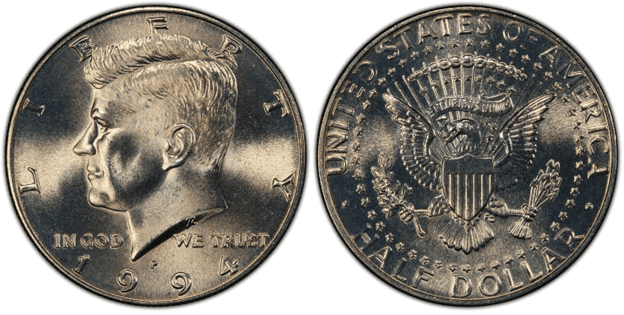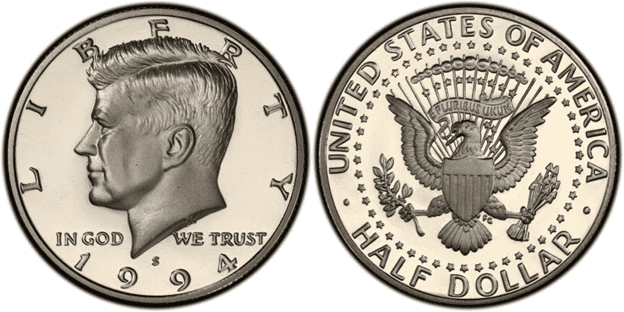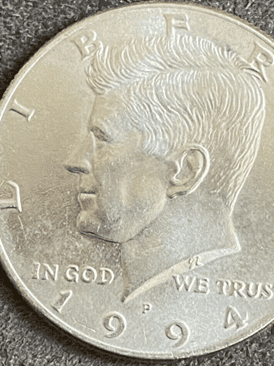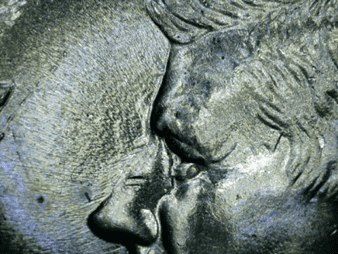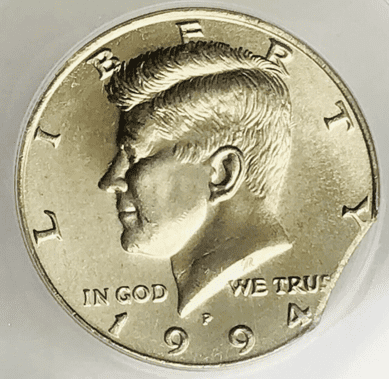What Is the 1994 Kennedy Half Dollar Made Of?
The 1994 half dollar is made of 75% copper and 25% nickel. Its core is made of pure copper but it is clad with nickel. Aside from that, in 1994, the U.S. Mint also produced a silver-proof version, which is made of 90% silver and 10% copper.
In the past, the Kennedy half dollar had different compositions. For example, in 1964, when it was first released, the Kenndy half dollar was made of 90% silver and 10% copper. From 1965 to 1970, the silver content was reduced to 40% and copper was increased to 60%.
The Kennedy half dollar has the following specifications:
- Value – 50 cents
- Mass – 11.34 g
- Diameter – 30.6 mm
- Thickness – 2.15 mm
- Reeded edge
The obverse of the coin was designed by Gilroy Roberts while its reverse was designed by Frank Gasparro. Both sides of the coin were designed in 1964.

photo source: USA Coin Book
As its name implies, the 1994 half dollar has the image of John Kennedy, which is facing to the left. Inscriptions include the following:
- IN GOD WE TRUST
- 1994
- LIBERTY
On the obverse, the design is essentially the same as the Presidential Seal. Thus, you’ll find an eagle with its wings outspread. On its beak, you’ll find the banner that states, “E Pluribus Unum,” which means “Out of many, one.”
In front of the eagle is the Union Shield. The radiating glory Or is seen to be behind and above the eagle. It has an arc of 13 cloud puffs and a constellation of 13 mullets argent.
The eagle holds an olive branch on its left talon while a bundle of thirteen arrows can be seen in its right talon. 50 stars encircle the eagle, which represents the 50 states of the country.
The 35th president of the United States was among the most popular presidents in the country’s history. That’s why, when the Kennedy half dollar was first issued, most people would rather hoard them than spend it. Thus, the Kenndy half dollar didn’t circulate that much back in 1964 even though the US Mint greatly increased its production.
Aside from that, during the late 1960s and following years, the value of silver steadily increased. All the more people were convinced to keep their Kennedy coins. This led the US Mint to reduce the fine silver content of the Kennedy coin, from 90% to 40%. Nevertheless, this didn’t encourage people to spend their Kennedy coin.
Thus, in 1971, the silver Kennedy coin was discontinued and replaced by the cupronickel Kennedy coin.
1994 Kennedy Half Dollar Varieties
The 1994 Kennedy half dollar comes in different varieties. The U.S. Mint produced the 1994 P, D, S, and silver versions. The main US Mints are located in Philadelphia, Denver, and San Francisco. The main difference among the 1994 half dollar varieties is their mint mark.
Aside from standard struck coins, there are also error coins that give rise to a different variety.
Here are the 1994 Kennedy half-dollar coins you should know:
1994 D Kennedy Half Dollar
Year of minting: 1994
Mint Mark: D
Place of minting: Denver
Quantity produced: 23,828,110
Face Value: $0.50 (one cent)
Price: $0.50 to $3.00 (or more)
Mass: 11.34 grams
Edge: Reeded
Designer: Gilroy Roberts (obverse)/Frank Gasparro (reverse)
Composition: 25% nickel and 75% copper
Diameter: 30.61 mm
Thickness: 2.15 mm

photo source: PCGS
The 1994-D half dollar coin was produced in the Denver Mint. At the end of 1994, there were more than 23.8 million of these coins produced. 1994-D half dollars with at least MS-66 are difficult to find. If you have one of these and it’s still in good condition, you can sell it for up to $3 or more.
1994 P Kennedy Half Dollar
Year of minting: 1994
Mint Mark: D
Place of minting: Denver
Quantity produced: 23,828,110
Face Value: $0.50 (one cent)
Price: $0.50 to $3.00 (or more)
Mass: 11.34 grams
Edge: Reeded
Designer: Gilroy Roberts (obverse)/Frank Gasparro (reverse)
Composition: 25% nickel and 75% copper
Diameter: 30.61 mm
Thickness: 2.15 mm

photo source: PCGS
The 1994-D half dollar coin was produced in the Denver Mint. At the end of 1994, there were more than 23.8 million of these coins produced. 1994-D half dollars with at least MS-66 are difficult to find. If you have one of these and it’s still in good condition, you can sell it for up to $3 or more.
1994 S Kennedy Half Dollar (proof)
Year of minting: 1994
Mint Mark: S
Place of minting: San Francisco
Quantity produced: 2,484,594
Face Value: $0.50 (one cent)
Price: $0.50 to $9.00 (or more)
Mass: 11.34 grams
Edge: Reeded
Designer: Gilroy Roberts (obverse)/Frank Gasparro (reverse)
Composition: 25% nickel and 75% copper
Diameter: 30.61 mm
Thickness: 2.15 mm

photo source: PCGS
The San Francisco Mint produced the 1994-S Kennedy half-dollar. This mint specializes in creating proof coins. This means that the 1994-S Kennedy half-dollar coins are shinier, more detailed, and more attractive.
Because proof coins are more time-consuming to produce, the San Francisco Mint only created about 2.4 million of 1994-S 50 cent coins. Its value is higher compared to other varieties. The price is usually around $0.50 to $9.00.
1994 S Silver Kennedy Half Dollar (proof)
Year of minting: 1994
Mint Mark: S
Place of minting: San Francisco
Quantity produced: 785,329
Face Value: $0.50 (one cent)
Price: $0.50 to $37.00 (or more)
Mass: 11.34 grams
Edge: Reeded
Designer: Gilroy Roberts (obverse)/Frank Gasparro (reverse)
Composition: 25% nickel and 75% copper
Diameter: 30.61 mm
Thickness: 2.15 mm

photo source: PCGS
Of all the official 1994 half dollar varieties issued by the US Mint, the silver half dollar version is the most expensive. On average, you can sell this for up to $37 or more. There were only about 785 thousand silver half-dollar coins.
List Of 1994 Kennedy Half Dollar Errors
As much as the US Mint would like to produce perfect coins, due to mechanical and human errors, there would still be some problems in the minting process. Thus, you would find rare Kennedy error coins.
As this might be the case, collectors are greatly interested in error coins. They are not just rare, but their unique appearance and attributes make coin enthusiasts even more than happy to add them to their collections.
Here’s an example of a 1994 Kennedy with multiple errors:

photo source: eBay
In this error, you’ll find a double chin, nose, and ear. This type of error commonly happens when the coin was struck twice by the die.
Another interesting error is the clashed die. This happens when the obverse and reverse dies are damaged upon striking each other. The die would break and the crack would show up on the coin. Here’s an example:

photo source: eBay
There are times as well when the planchet wasn’t cut correctly. This results in having a clipped area of the coin as shown here:

photo source: eBay
How Much Is 1994 Kennedy Half Dollar Worth Today?
The 1994 Kennedy half dollar isn’t worth that much if you’re just going to base it on its face value, which is $0.50. Its melt value is just $0.0999. However, the melt value of the 1994 silver Kennedy coin is much higher, which is $7.9356.
Nevertheless, there are still 1994 Kennedy half dollars that are super valuable. Here’s a 1994 Kennedy Half Dollar values chart to help you gain an overview of their prices:
| Coin | Condition | Grade | Mintage | Value |
| 1994 D Kennedy half dollar | Circulated/mint | Not graded | 23,828,110 | $0.50 to $3.00 |
| 1994 D Kennedy half dollar | Uncirculated/mint | MS-65 | 23,828,110 | $12 to $20 |
| 1994 D Kennedy half dollar | Uncirculated/mint | MS-66 | 23,828,110 | $10 to $30 |
| 1994 D Kennedy half dollar | Uncirculated/mint | MS-67 | 23,828,110 | $67 to $364 |
| 1994 P Kennedy half dollar | Circulated/mint | Not graded | 23,718,000 | $0.50 to $3.00
|
| 1994 P Kennedy half dollar | Uncirculated/mint | MS-66 | 23,718,000 | $10 to $23 |
| 1994 P Kennedy half dollar | Uncirculated/mint | MS-67 | 23,718,000 | $18 to $40 |
| 1994 P Kennedy half dollar | Uncirculated/mint | MS-68 | 23,718,000 | $1,469 to $2,115 |
| 1994 S Kennedy half dollar | Uncirculated/proof | Not graded | 2,484,594 | $0.50 to $9.00 |
| 1994 S Kennedy half dollar | Uncirculated/proof | PR-68 | 2,484,594
|
$9 to $17 |
| 1994 S Kennedy half dollar | Uncirculated/proof | PR-69 | 2,484,594
|
$10 to $17 |
| 1994 S Kennedy half dollar | Uncirculated/proof | PR-70 | 2,484,594
|
$19 to $53 |
| 1994 S Silver Kennedy Half Dollar (proof) | Uncirculated/proof | Not graded | 785,329 | $0.50 to $37.00 |
| 1994 S Silver Kennedy Half Dollar (proof) | Uncirculated/proof | PR-68 | 785,329 | $146 |
| 1994 S Silver Kennedy Half Dollar (proof) | Uncirculated/proof | PR-69 | 785,329 | $15 to $84 |
| 1994 S Silver Kennedy Half Dollar (proof) | Uncirculated/proof | PR-70 | 785,329 | $47 to $207 |
How Does The Grading System Work?
The Sheldon Scale is used by numismatists to provide a numerical value to coins. The Sheldon Scale goes from poor (P-1) to perfect mint state (P-1) (MS-70). Coins were originally evaluated using words to reflect their condition (Good, Fair, Excellent, Etc.). Unfortunately, coin collectors and dealers had different ideas about what each of these terms represent.
Professional numismatists joined together in the 1970s and established CoinGrading standards. These numismatists now assign grades at key places on the seventy-point scale, using the most regularly utilized numeric points in conjunction with the original adjective grade. The following are the most common coin grades:
-
-
- (P-1) Poor – Indistinguishable and probably damaged; if used, must have a date and mintmark; otherwise, rather battered.
- (FR-2) Fair – Nearly smooth, but without the damage that a coin graded Poor often possesses. The coin must have enough detail to be identified.
- (G-4) Fair – Inscriptions have merged into the rims in some areas, and important elements have been mostly erased.
- (VG-8) Very Good- A little weathered, but all of the primary design elements are visible, albeit faintly. There is little if any, central detail left.
- (F-12) Good – The item is very worn, yet the wear is even, and the overall design details stand out clearly. Rims are almost completely isolated from the field.
- (VF-20) Very Fine – Moderately weathered, with some finer features still visible. The motto or all letters of LIBERTY are readable. Both sides of the coin have entire rims that are separated from the field.
- (EF-40) Extremely Fine – Gently used; all gadgets are visible, and the most important ones are bold. The finer details are bold and clear, however, light wear may be seen.
- (AU-50) Uncirculated – Slight evidence of wear on the coin’s design’s high points; may have contact marks; eye appeal should be adequate.
- (AU-58) Uncirculated Choice – Slight traces of wear, no severe contact marks, almost full mint shine, and great eye appeal.
- (MS-60) Mint State Basal – Strictly uncirculated; no indication of wear on the coin’s highest points, but an unsightly coin with reduced luster, visible contact marks, hairlines, and other flaws.
- (MS-63) Mint State Acceptable – Uncirculated, but with contact scratches and nicks, little reduced shine, but otherwise appealing appearance. The strike is weak to average.
- (MS-65) Mint State Choice – Uncirculated with great mint shine, very little contact blemishes, and exceptional eye appeal. The strike is unusually severe.
- (MS-68) Mint State Premium Quality – Uncirculated with superb luster, no obvious contact marks to the naked eye, and exceptional eye appeal. The strike is quick and appealing.
- (MS-69) Almost Perfect Mint State – Uncirculated with perfect brilliance, a sharp and appealing strike, and extremely good eye appeal. A near-perfect coin with minor imperfections in the planchet, strike, and contact markings (seen only under 8x magnification).
- (MS-70) Mint State Perfect – Under 8x magnification, there are no tiny imperfections discernible; the strike is crisp, and the coin is perfectly centered on a beautiful planchet. Rarely seen on a coin, this coin is bright and whole, with original luster and exceptional eye appeal.
-
Where To Buy Or Sell 1994 Kennedy Half Dollar?
The most common places to buy 1994 Kennedy half dollar coins would be on the Internet. There are literally hundreds of places online to do this. However, to give you a headstart, you can go to Amazon, eBay, and Etsy. These are the most common marketplace platforms that allow you to buy and sell 1994 Kennedy half dollar coins.
Aside from the Internet, there should be coin shops near your place. A simple Google search would reveal that there might be buyers and sellers in your local area. If you can, try to join coin clubs and find enthusiasts who share your interest. They can tell you places where you can buy and sell 1994 Kennedy half dollar coins.
FAQs
What is the value of a 1994 half-dollar?
The value of the 1994 half-dollar is $0.50 if you’re going to base it on its face value. Its melt value is $0.01. If you have the silver 1994 half dollar coin, it has a melt value of $7.94. However, 1994 half dollar coins with grades MS-66 and above can be more expensive.
How can you tell if the Kennedy half-dollar is silver?
You can tell if a Kennedy half-dollar is silver if it looks silvery to you. You can also weigh your coin. Silver coins are heavier than the cupro nickel coins.
Moreover, you can do a drop test. Silver coins have a higher pitch sound while standard coins would have a dull and short ringing sound. Aside from that, look at the edge of the coin. You should see solid silver stripes if it is silver.
If you really want to establish whether you have a silver coin or not, you can simply go to a coin appraiser and have your coin assessed.
How much is the 1994 Kennedy half dollar with multiple errors worth?
A 1994 Kennedy half-dollar with multiple errors can be bought for around $250 to $350. The price can even be higher than that especially if the coin is rare and still in good condition.

